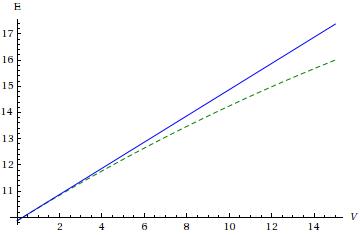
Probably the simplest example we can think of is an infinite square well with a low step half way across, so that for , for and infinite elsewhere. We treat this as a perturbation on the flat-bottomed well, so for and zero elsewhere.
The ground-state unperturbed wavefunction is , with unperturbed energy . A “low” step will mean . Then we have
This problem can be solved semi-analytically; in both regions the solutions are sinusoids, but with wavenumbers and respectively; satisfying the boundary conditions and matching the wavefunctions and derivatives at gives the condition which can be solved numerically for . (You ought to try this, it will be good practice for later sections of the course.) Below the exact solution (green, dotted) and (blue) are plotted; we can see that they start to diverge when (everything is in units of ).

We can also plot the exact wavefunctions for different step size, and see that for (the middle picture, well beyond the validity of first-order perturbation theory) it is significantly different from a simple sinusoid.

Another example is the harmonic oscillator, with a perturbing potential . The states of the unperturbed oscillator are denoted with energies .
Recalling that in terms of creation and annihilation operators (see section A.4), , with , and so
The first-order change in the wavefunction is also easy to compute, as unless . Thus
We can see a pattern emerging, and of course this is actually a soluble problem, as all that the perturbation has done is change the frequency. Defining , we see that the exact solution is
in agreement with the perturbative calculation.